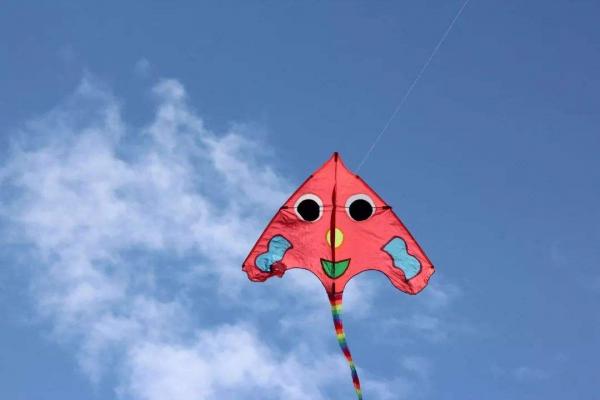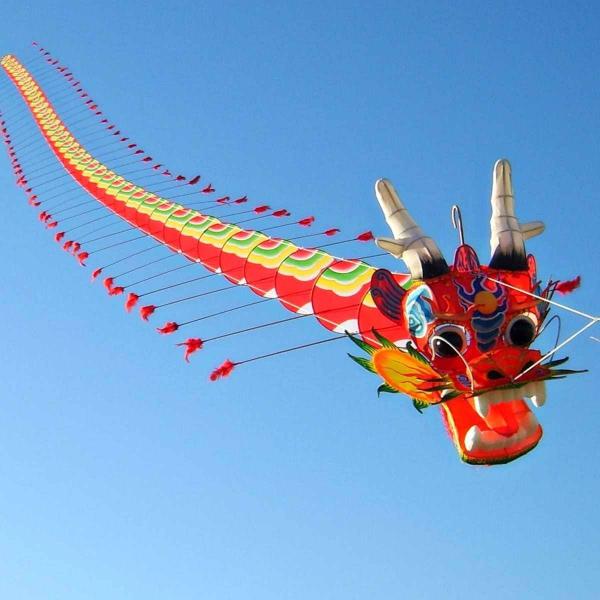Chinese Kite
History of Chinese Kite
The first kite was invented by Chinese people over 2, 000 years ago, in the 5th-century BC during the Warring States Period by Mozi (墨子) and Lu Ban (鲁班). Before paper was invented, bamboo and silk are used to make kites, which are proved by many historical written documents. Since the 2nd century, paper has been widely used in kite craftwork, and it got another name "paper glede (纸鸢)". Due to cheaper material, kites began to popular among common people. Kites were firstly used for military purpose, and later were mainly for entertainment or regarded as art of work. They were made by folk artisans from all over China and developed different types and styles.
Military use of kites in ancient China
Originally, kites were used for military purposes. Kites in wartime were used to send signals to other troops or to carry warriors to high sky that could fire down the enemy below. The most famous battle use Chinese kite was Chu-Han War in 203 - 202 BC. The General Zhang Liang ordered his solider to fly big kite which could carry a solider to sky in the foggy night. There were many kites used and his soldiers all singing the songs popular in enemy's hometown. The enemy troops were touched and all missing their home town. A troop without fighting courage was easily conquered. Xiang Yu, who has been wise and powerful for a long time, loses this war then took his own life away.
Marco Polo and the spreading of Chinese Kites
Chinese Kite was introduced to other parts of the world by Marco Polo in the 13th century, describing the blessing voyage and flying kite. He wrote that Chinese merchandises tied someone to a huge kite and launched it before sailing; if the kite went high and kept a good condition, which meant prosperous and quick shipping.

Symbolic Meaning of Chinese Kite
Traditional Chinese kite features auspicious motifs. From long period ago, Chinese ancestors not only created beautiful painting on kites, but also created auspicious patterns meaning yearning and pursuit for a better life. Seeking Fu, health & longevity, happiness and lucks were the most common content s a kite mean. Dragonfly, swallow, dragon, butterfly, flowers, birds and other images all contain rich meanings. Tortoises, cranes and peaches signify long life, while a dragon design represents power and prosperity.
Today, kite flying can also be found around China in spring. It is a great family activity that children and parents have funs, but less people regard warding off evil spirits bringing good lucks.
How to make a Chinese Kite
Materials for Chinese Kite making
Four Steps to Make a Chinese Kite
Most Chinese kites are made with a 3-D bamboo frame with silk or paper covering. Even a young man can make a simple kite in China by taking several steps: binding, pasting, painting, and flying. These basic four skills are required for not only a huge kite but a miniature one.
Step 1 - Binding: Including processing bamboo with techniques of selecting, splitting, peeling and bending. And then bind a bamboo frame with different bamboo strips, make sure it is symmetry and support the kite balanceable.
Step 2 - Pasting: Choose lightweight but strong paper, silk or cloth first, and then cut it into the shape that can fit the bamboo frame. Make sure it is a little bit larger than the face it covers. Stuck the cut paper or silk to the frame with paste or glue. Adjusting is usually necessary to make sure the kite neat and strong.
Step 3 - Painting: Give the rein to your imagination and paint the kite into a work of art.
Step 4 - Flying: Choose a windy day and find an open area, like a square or grassland by the river, you can easily fly the kite up to the sky by adjusting the thread.
>> More details at Step-by-step Guide of Making a Chinese Kite

Best time to fly kites in China:
Kite Flying Skills
Common Styles of Kites
• Rigid Winged: is usually made of two bamboo strips attached to a rectangular framework, which is covered with paper or silk to form a triangle to ensure a good wind-catching effect and good flight performance.
• Soft Winged: is probably the most popular type of Chinese traditional kites. It is made of one bamboo strip. The wings of this kind of kite have rigid upper rims. The lower sections of all these wings are soft and flexible, hence allowing the kite to float in the air lightly and agilely. Many soft winged kites have more than one pair of wings, which are arranged one pair above the other. They can be made into images of birds, insects, fishes, and so on. Most of the soft winged kites are foldable and easy to carry.
• Flat Style: is the easiest kites to make and fly. Kites have a single plane, and are made of a completely rigid bamboo frame. Spars frame all the four sides of the frame or of the frame segments. Most of these kites have long tails to grant a stable in-flight behavior.
• Centipede or Dragon: with a head followed with a train of equally dimensioned kite disks and interconnected with one or three lines, Centipede kites or dragon kites can reach a length of over 6000 meters. These kites give an attractive and vivid in-flight view, especially when the wind moves and deforms the kite train.
Best Known Chinese Kite Cities
Kaifeng, Beijing, Tianjin, Weifang, Nantong and Yangjiang are said to be the top 6 traditional origins of Chinese kites. As an art, Chinese kites have developed endlessly alongside the long history of local cultural traditions, including the music, dance, drama, folk-custom, and religion of their respective areas.
Beijing Kites
The characteristics of Beijing kites include delicate frameworks, precise colored drawings, naturalness and gracefulness, and a high worthiness of being viewed and admired. There are usually seven kinds of artistic sculptures concerning Beijing kites: pricking swallow, hard wing, soft wing, symmetrical swallows, board, cluster, and canister.
Best places to fly kites in Beijing
Chaoyang Park, Sun Palace Park, Qianhai Square, Wanfeng Park, Fengtai Park (Square by the lake), Ludi Park (by Yongding River), Canal Culture Square, Jianhe Park, Xihaizi Park
Weifang Kites
Weifang is a city of Shangdong Province. It is called "world kite capital", famous for the exquisite craftsman work, painting, well-balance fly of kites. Weifang kites fully demonstrate folk custom and vividness, which comes from adopting the advantages of other kinds of kites, especially Beijing and Tianjin Kites. Similar to Yangliuqing of Tianjin, Weifang Yangjiafu is also famous for New Year woodcut picture. Kite art has absorbed techniques, skill and vivid color style from this traditional Chinese painting. It forms a unique feature of being exquisite in sculpture and delicate and gorgeous in artwork, which has become one of the important genres of Chinese kites.
Every late April, the Weifang International Kites Festival is held and draws many kite-fans. Thousands of kites from home and abroad were exhibited and flied into the high sky.
In April of 2021, a huge kite of centipede with dragon head flied above the northern beach in Weifang during the 38th Weifang International Kite Festival. The kite, which was 280 meters long with a diameter of 1.5-meter in the middle and a head of 4.2-meter in height and 3.6-meter in width, was said to be the biggest one all over the country at that time.
Nantong Kites
Kites from Nantong are most notable for the sound devices they use. Numerous whistles, big and small, are mounted on Nantong kites, leading to their nickname, "Symphony on Air."
Tianjin Kites
The outstanding characteristics of Tianjin kites are the techniques of the framework and fastening and especially the using of bright colors. Based on traditional Spring Festival wood block print in Yangliuqing, Tianjin kites try to be unique, aiming to find something new and fresh in design and painting.
Kaifeng Kites
As one of the most ancient capitals in China, Kaifeng has a long history of kite making as well. In Kaifeng, people fly kites on Qingming Festival, and when kite is launched high up to the sky, flyer will deliberately cut the kite line to let the kite float with the wind, which means to completely release the "depression" accumulated over the past year, so as not to get sick in a year. Moreover, the kite places hope. For example, the painting of bats, peaches, pine trees and cranes on the kite means good fortune and longevity.